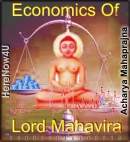
Question:
Mohammad Saheb, who did not prohibit meat eating, regards earnings through interest as forbidden, and the Jains, believing in non-violence, do the business of interest earning. Why is it so?
Answer:
In Jain literature, the two aspects of the phenomenon of interest are considered. It mentions about the Jain shravakas who used to pursue the business of money lending and also those who regarded earning interest as violence, which should be completely given up by the shravakas (devotees). Interest is a complicated question. There are two aspects of it; one is of giving help and the other is of exploitation. Let us take an example. Incapable people do not get money and suffer. One may give money to such people; and in consideration, something may be received. Inspired by such an idea, people used to give money to others and the people with small means used to manage their affairs. This would have been the initial inspiration for charging interest. This is an aspect of help. It cannot be rejected. But when such a tendency develops beyond limits, then its initial inspiration changes and a newer and different motivation emerges. The inspiration to help ends and the selfish motive takes the upper band. It is a fact that so much interest began to be charged that it led to exploitation by taking advantage of those with small capacities. The latter's helplessness was grossly misused. From this point of view, interest became a highly condemnable element.
Mohammad Saheb prohibited interest. In the given context, he did the right thing. During that period, in the middle ages, business had overlooked the objective of cooperation. The entire business of interest took the form of exploitation. He witnessed those conditions and he prohibited it. Today, the banking business goes on. The entire business has become the business of earning interest. That is collective business and, therefore, there is no exploitation. It is a refined form of exchange. Not all, therefore, are worried about it. Even those who prohibit interest also make use of it.
When I consider this problem from both points of view, it appears tome that it cannot be said that it is to be totally obtained or that it is totally desirable. If the system could be refined, if somebody could reactivate the inspiration of cooperation, then its usefulness cannot be rejected. On the other hand, exploitation has to be considered as a taboo.
We have seen that there is excessive exploitation where there is so much of compulsion and prohibition. Under compulsion, one has to make payment. This position is totally undesirable. We should express our opinion on this only after considering both aspects. In the context of the present problem, it should be maintained that selfishness and exploitation associated with interest should go out of interest. If this goes out, and only rule-bound cooperation remains, as is being followed in the banking business, it appears to me that the question of rejecting it totally does not come in the context of practical reality. Perhaps, because of this when Bhagwan Mahavira listed unethical sources of income, he did not make any mention about interest. It appears that this aspect was not so clear in those times and everything was practiced on the basis of cooperation. The conditions in the middle ages gave rise to the exploitative aspect of the practice; and from that point of view, the prescription of Mohammad Saheb can be regarded as rational. He created an awakening against acts of exploitation. For Jain society, the question should be considered variously in the context of olden times, of the middle ages and of today. In the context of the present age, the only question before the Jain society is that some steps should be taken in the direction of ending exploitation that has been associated with it, and not in ending its usefulness.
 Acharya Mahaprajna
Acharya Mahaprajna

